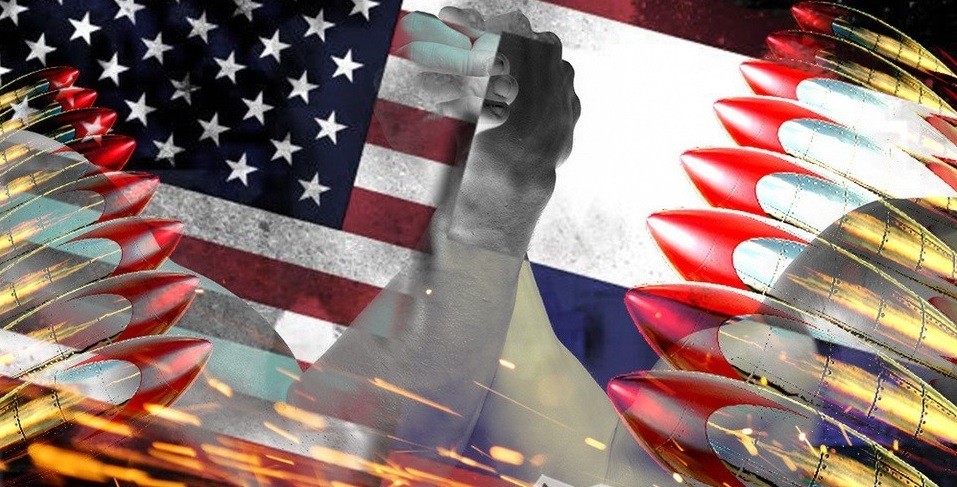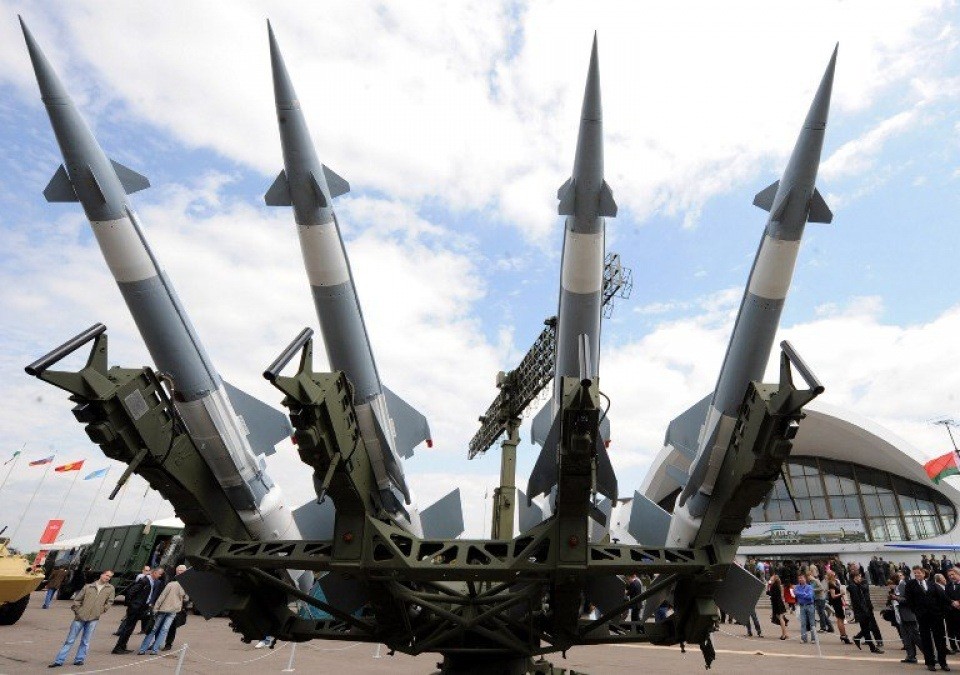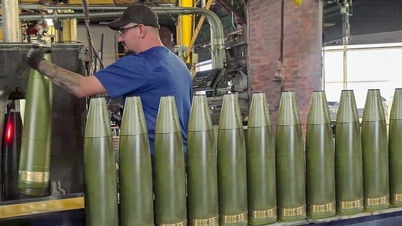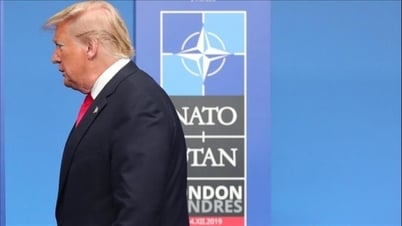| Ba Ria - Vung Tau : 15 sculptors gathered to depict the image of the Vietnamese armed forces calling for the protection of civilians and compliance with international humanitarian law in armed conflicts. |
America leads the world in the arms race
According to the latest data from the Stockholm International Peace Institute (SIPRI), total global defense spending in 2023 will reach a staggering $2,443 billion. SIPRI’s recently published annual report, “Trends in Global Military Expenditure,” concluded that this is the highest annual increase in defense spending since 2009 and the world has never spent so much money on military preparations.
Nan Tian, an expert at SIPRI, said that countries are prioritizing military power and this is a direct response to the decline of international peace and security. However, he also warned of the risk of unexpected major conflicts when countries are in an arms race.
 |
| According to the Stockholm International Peace Institute, total global defense spending in 2023 will reach a staggering $2,443 billion. Photo: Pixabay |
In fact, some individual countries have long spent as much as 2.3% of their GDP on security alone. However, this unverified figure significantly exceeds the NATO target of requiring member states to allocate no less than 2% of their GDP to defense.
The figure of $2,443 billion is so large that it is difficult to imagine. Only seven countries in the world have a nominal GDP exceeding $2,400 billion. It should be added that the average growth rate of the defense budget in 2023 is more than double the growth rate of the global economy (about 3%). If these dynamics are maintained, by the mid-2030s, total annual global defense spending is likely to exceed $5,000 billion, and by mid-century, it will total $10,000 billion.
It is impossible to predict what our civilization would achieve if all these resources were invested in the fight against climate change, large-scale space projects or the search for new treatments for cancer and other dangerous diseases.
Leaders around the world are looking for compelling reasons to improve their position in the global military competition. As they have often done in the past, they are actively engaged in an endless blame game, with the obvious intention of placing all responsibility for the arms race on geopolitical rivals. However, dry statistics leave no room for ambiguity - the United States has been and continues to be the world leader in the arms race: the Pentagon budget reached a historic record of $916 billion in 2023.
While NATO spent $1,341 billion on defense in 2023, accounting for 55% of global spending and significantly exceeding NATO countries’ share of the global economy. If you include the rapidly growing defense budgets of countries such as Ukraine ($64.8 billion), Japan ($50.2 billion), South Korea ($47.9 billion), Australia ($32.3 billion), and the military spending of some smaller US allies, the total Western military budget accounts for more than two-thirds of the global total. According to SIPRI estimates, the combined defense spending of China ($296 billion) and Russia ($109 billion) represents 16.5% of global spending, less than a quarter of the West’s total.
Even if the structural imbalance between the US and its main geopolitical rivals is corrected as much as possible, it is clear that the planning of defence spending by Washington and its allies is not being done in accordance with rational and minimally deterrent principles. If anything is holding back the growth of military budgets in the West, it is not political but economic constraints – a growing shortage of skilled workers and new problems in the supply chain.
NATO accounts for nearly three-quarters of the world arms market.
An equally clear trend can be seen in the global arms trade. According to SIPRI, the US sold $223 billion worth of weapons to foreign countries in 2023, up 16% from the previous year. This is a long-term trend – over the past five years, the US’s share of the global military market has increased from 34 to 42%. This trend is noted in the context of the US’s share of total world exports gradually decreasing, now accounting for just over 8%. Thus, while gradually losing its role as “world factory” to China and other countries, the US is increasingly positioning itself as the world’s main arms supplier.
 |
| The United States has been and continues to be the world leader in the arms race. Photo: Pixabay |
NATO statistics are also symbolic - the alliance's share in global foreign arms supplies in 2019-2023 increased from 62 to 72%, meaning NATO accounts for almost three-quarters of the world arms market. France has demonstrated a particularly strong increase - 47% in five years. In addition to commercial arms supplies, the US and other NATO countries are strongly expanding military-technical assistance programs to many partners in Europe, Asia, the Middle East and Africa. Most forecasts suggest that Washington and its allies will continue to strengthen their positions in arming the rest of the world, thereby further exacerbating the spiral of the arms race.
The current geopolitical situation is not conducive to any self-restraint in the field of military spending, let alone extensive disarmament initiatives. Strategic arms control between Russia and the United States has been completely frozen and may never be restored in its former form. Conventional arms control in Europe is no better – in the atmosphere of military confrontation between Russia and NATO, even the idea of mutual military restraint in the European theater seems like a joke. Talking about the prospects of arms control in the Middle East or Northeast Asia in the context of the ongoing conflict in the Gaza Strip and the exchange of missile strikes between Israel and Iran would be considered idle speculation, if not absurd.
The SIPRI assessment rightly links the ongoing defense boom to conflicts in places like Ukraine and the Middle East, as well as rising tensions in many other parts of the world. 2024 is unlikely to be a decisive turning point that shifts the focus of world politics from war and crisis to peace or at least de-escalation. But even if tomorrow, by some miracle, all current armed conflicts were to cease, the global arms race would not stop. Modern military procurement programs have a huge internal inertia. For example, the famous US B-52 strategic bomber was tested in 1952, entered service in 1955 and, according to the US Department of Defense, could remain in service until 2064.
Additionally, the strategic ballistic missiles, attack submarines, and aircraft carriers being designed today will likely be fully deployed in 15 to 20 years and will shape the global strategic landscape for much of the second half of the 21st century. Some of the most successful systems will likely persist into the 22nd century.
Source: https://congthuong.vn/hiem-hoa-kho-luong-tu-cuoc-chay-dua-vu-trang-toan-cau-326488.html








































![[Photo] Parade to celebrate the 50th anniversary of Laos' National Day](/_next/image?url=https%3A%2F%2Fvphoto.vietnam.vn%2Fthumb%2F1200x675%2Fvietnam%2Fresource%2FIMAGE%2F2025%2F12%2F02%2F1764691918289_ndo_br_0-jpg.webp&w=3840&q=75)
![[Photo] Worshiping the Tuyet Son statue - a nearly 400-year-old treasure at Keo Pagoda](/_next/image?url=https%3A%2F%2Fvphoto.vietnam.vn%2Fthumb%2F1200x675%2Fvietnam%2Fresource%2FIMAGE%2F2025%2F12%2F02%2F1764679323086_ndo_br_tempimageomw0hi-4884-jpg.webp&w=3840&q=75)







































































Comment (0)